 Cambodia's
changing image Cambodia's
changing image |
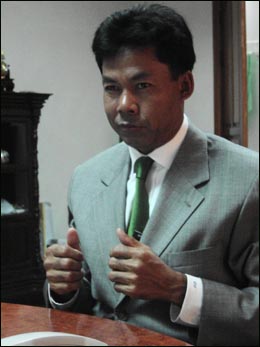
According to the Minister
of tourism, H.E. Veng Sereyvuth the recent
surge in this sector must be accounted for the
"great change in the image of the country"
through the improvement of social living conditions
and upgrading of facilities. Indeed, with an average
growth of 20 to 30%, tourism has become one of
the strongest sectors in the Cambodian economy
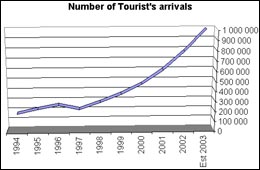
Tourism related activities - hotels and restaurants
- grew at an average annual rate of 30 percent
over 1994-1995. It slowed down during 1996-98,
but picked up again in 1999 when it grew by 20
percent. Over the last few years, the development
in the tourism industry has made a significant
contribution to economic growth by attracting
foreign investments, creating jobs and generating
income for the local people.
If the country suffered from a negative image
from the war's legacy, "there is right now
an opportunity that has been missing for 30 years"
says H.E.
Veng Sereyvuth, Minister of Tourism. Indeed
the ASEAN Tourism Forum, which took place in Phnom
Penh last January, served as a positive testing
ground for Cambodia's ability to handle a project
of international scope and was an exceptional
springboard for the launching of "the Visit
Cambodia Year" with a slogan " Cambodia
World of Treasure".
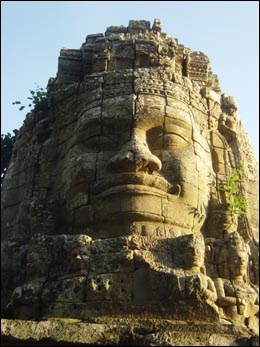
Though, tourism still suffers Cambodia's 3 decades
of war, the priority for the next five years are
lying mainly in the development of the overall
infrastructure.
 Transport
re-facing Transport
re-facing |
With improved infrastructure - Airport renovation
and construction projects are currently implemented
or planned at Pochentong, Siem Reap, Ratanakkiri,
Stung Treng, Kampong Chhnang, plus the addition
of Sihanoukville as a regional airport and the
completion of a major road network that will connect
all parts of the country in the next 3 to5 years
- the potential for tourism in Cambodia is immense.
Indeed development of tourism markets depends
largely on improved access to, and movement within,
Cambodia. This future diversification of domestic
flights will thus provide tourist access to a
wider range of destinations.
At the Ministry
of Tourism there seem to be confidence on
this part. As H.E.
Veng Sereyvuth forecasts that by "2008;
we will have a complete infrastructure in terms
of road link. With the ASEAN highway from Thailand
to Vietnam and all the national road links up
to Laos and the national road to Angkor Wat."
Furthermore the Open Sky policy, launched by
the Royal Government allowed foreign airline companies
to fly directly to Siem Reap and the Angkor temples,
which brought in a large amount of foreign and
local tourists to Angkor Wat. Thanks to this initiative
Cambodia has given direct access to its major
tourist assets but the road access from Thailand,
Vietnam or other tourism oriented neighbors, is
still lacking. Mr. Meng Hieng, Managing Director
of Exotissimo and president of the Cambodian Association
of Travel Agents (CATA) considers that "if
we could attract to Cambodia a small percentage
out of those 10 million tourists that each country
(Thailand, Vietnam…) receives, that would
mean a real development in terms of tourism"
and that "when we talk about tourism growth
in Cambodia, we are not talking about 3% or 5%
but about 25% to 35% each year".
Nevertheless the Open Sky Policy focuses only
in the development on the main tourist asset of
the country; the Angkor Wat complex, and has left
behind other destinations such as the capital
city. Reaching the core of this issue Michel G.L.
Horn, Managing Director of Cambodiana investment
PTE. Ltd, owner company of Hotel
Cambodiana declares "The
Cambodiana's Hotel development strategy has
to focus on business because as long as the Open
Sky Policy is in place and as long as the country
is not completely open; with new destinations
where we can offer various packages for tourists
to stay three, four, five nights within Cambodia,
tourists may carry on to bypass Phnom Penh".
|
Professionals underline the importance of diversifying
the "products" offered within Cambodia
and to establish a clear and comprehensive development
and communication plan for the sector.
 Development
plans Development
plans |
The government has framed for the sector a development
plan focused on 4 strategic regional areas symbolically
forming a dragon: Siem Reap (Cultural tourism)
with the Angkor complex, Phnom Penh (body of the
dragon, business tourism), Sihanoukville (head
of dragon for tourism and industry with the sea
tourism) and Rotanak-kiri eco-tourism (tale of
the dragon). The government aims at developing
an overall strategy for tourism development with
among others the establishment of a tourism attraction
information database. This will concentrate on
information concerning the tourism product: the
categories of attractions (built cultural heritage
resource, living cultural heritage, events and
festivals, natural heritage site, recreation,
entertainment, rural/farm, adventure), their location,
type, ownership, legal status, visitation pattern,
and accessibility, giving information about the
planning/regulatory framework, tourism and general
physical infrastructure, facilities, services,
economic impact, and utilities and lastly a database
will describe the various types of local attractions
in terms of their planning and management capacities,
attributes of the attraction, and facilities and
services available.
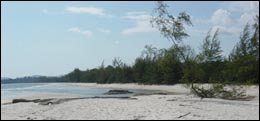
 Eco-tourism
and sustainable developments Eco-tourism
and sustainable developments |
Cambodia has good prospects for developing both
eco-tourism and cultural tourism. The Angkor Temples
and pristine environments of Cardamom Mountains,
and other protected forest and wildlife areas
offer good potential for development. However,
this ought to be pursued on a sustainable basis.
The Government's APSARA
Authority and Angkor Conservation commission
has allocated 1100 hectares of land in Siem Reap
for a tourism development Zone, south from the
protected area of the site. Bun Narith, President
Executive Director of APSARA
Authority explains that "the Authority
has signed with the Meta Mékong group for
the development of a 8 ha zone through a 70 year
concession. A 30 ha zone has been reserved for
the construction of hotels". APSARA Authority
has primarily set the objective to maintain a
balance between actions to protect the cultural
heritage and the environment and the need to develop
a strong tourism industry as part of a necessary
socio-economic development in Siem Reap. Offering
service will be a token of a worthy experience
for the tourist. Fifteen international organisations
are actively working with APSARA Authority in
order to preserve the temples. It also undertook
the training of monument guards and offers local
residents the tourism related employment opportunities.
H.E.
Sok An, Minister in charge of the council of Ministers
explains that thanks to its "Environment
awareness oriented policy; Angkor will be the
world's first cultural heritage site to be awarded
an ISO 14001 certificate for the implementation
of environment". There is a strong desire
to protect the historical legacy in Cambodia,
considering that tourism development can be sustainable
by maintenance of the integrity of cultural and
religious traditional matched with proper management
of the natural and environment protection.
 Cambodia:
a future one-stop destination? Cambodia:
a future one-stop destination? |
Tourism arrivals in Cambodia are estimated to
reach one million in 2003 to 2.2 million by the
year 2006, generating more than US$1 billion in
foreign exchange earnings.
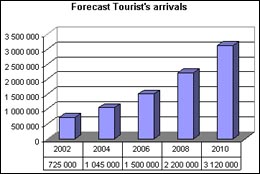
Tourism in Cambodia has bucked the trend that
saw many global and regional tourism destinations
suffer adversely from the general regional crisis.
Furthermore Cambodia has experienced no decline
at all in visitor numbers; in fact on the contrary
Cambodia is expected to record growths of at least
25% year-on-year between now and 2006.
The average tourist stays about three days in
Cambodia currently and spends an estimated US$400
during their stay. Most of the parties involved
in tourism in Cambodia agree to state that one
of the main tasks is to bring visitors to extend
their stay as Marc Bessagat, General Manager of
the Sofitel Royal Angkor
points out "We are not yet a one stand destination…we
need to develop this new concept, we are all collaborating
in the whole industry sector in order to increase
this stay".
The challenges are set; implement the national
infrastructure for a better accessibility of the
several tourist sites, such as Rattanak Kiri in
the East of the country. Develop a better infrastructure
to welcome all kind of tourists, especially in
the coastal area, where many projects are being
developed such as golf's and five stars complexes.
Last but not least diversify and promote the several
assets of Cambodia in order to make it a one-stop
destination. The renewed political peace and stability
is the first step to all these achievements and
step-by-step, with its world famous Angkor temples,
Cambodia is gaining popularity.
|

